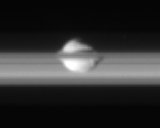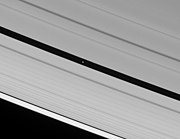 Pan amid the rings of Saturn. The 'side' view gives Pan the appearance of being embedded in the rings, although it actually travels in the empty Encke Division. | |
| Discovery | |
|---|---|
| Discovered by | M. R. Showalter |
| Discovery date | July 16, 1990 |
| Semi-major axis | 133,584.0±0.1 km |
| Eccentricity | 0.0000144±0.0000054 |
| Orbital period | 0.575050718 days (13.801217 hours) |
| Inclination | 0.0001°±0.0004° |
| Satellite of | Saturn |
| Physical characteristics | |
| Dimensions | 35 × 32 × 21 km[2] |
| Mean radius | 14.2 ± 1.3 km[2] |
| Mass | 4.95 ± 0.75 × 1015 kg[2] |
| Mean density | 0.41 ± 0.15 g/cm³[2] |
| Equatorial surface gravity | 0.001 m/s2 |
| Escape velocity | ~0.006 km/s |
| Rotation period | synchronous |
| Axial tilt | zero |
| Albedo | 0.5 |
| Temperature | ~78 K |
| | |
Pan (pronounced /ˈpæn/ pan, or as in Greek Πάν) is the innermost moon of Saturn. Pan is a "walnut-shaped" small moon about 35 kilometres across and 23 km high that orbits within the Encke gap in Saturn's A Ring. It acts as a ring shepherd and is responsible for keeping the Encke gap open.
Prediction
The existence of a moon in the Encke gap was first predicted by Jeffrey N. Cuzzi and Jeffrey D. Scargle in 1985, based on wavy edges of the gap which indicated a gravitational disturbance.[3] In 1986 Showalter et al. inferred its orbit and mass by modeling its gravitational wake. They arrived at a very precise prediction of 133,603 ± 10 km for the semi-major axis and a mass of 5–10 × 10−12Saturn masses, and inferred that there was only a single moon within the Encke gap.[4] The actual semi-major axis differs by 19 km and the actual mass is 8.6 × 10−12 of Saturn's.
The moon was later found within 1° of the predicted position. The search was undertaken by considering all Voyager 2 images and using a computer calculation to predict whether the moon would be visible under sufficiently favorable conditions in each one. Every qualifying Voyager 2 image with resolution better than ~50 km/pixel shows Pan clearly. In all, it appears in eleven Voyager 2 images.[5][5][6]
Orbit
The eccentricity of Pan's orbit causes its distance from Saturn to vary by ~4 km. Its inclination, which would cause it to move up and down, is not distinguishable from zero with present data. The Encke Gap, within which Pan orbits, is about 325 km wide.
[edit] Geography
Cassini scientists have described Pan as "walnut-shaped"[7] owing to the equatorial ridge, similar to that on Atlas, that is visible in images. The ridge is due to ring material that Pan has swept up from the Encke gap.
Pan ringlet
The Encke Division contains a ringlet that is coincident with Pan's orbit, indicating that Pan maintains the particles in horseshoe orbits.
Name
The moon was named on 16 September 1991,[8] after the mythological Pan, who was (among other things) the god of shepherds. This is a reference to Pan's role as a shepherd moon. It is also designated Saturn XVIII.[9] It was discovered by Mark R. Showalter in 1990 from analysis of old Voyager 2 probe photos and received the provisional designation S/1981 S 13 because the discovery images dated back to 1981.[10]



0 comments:
Post a Comment